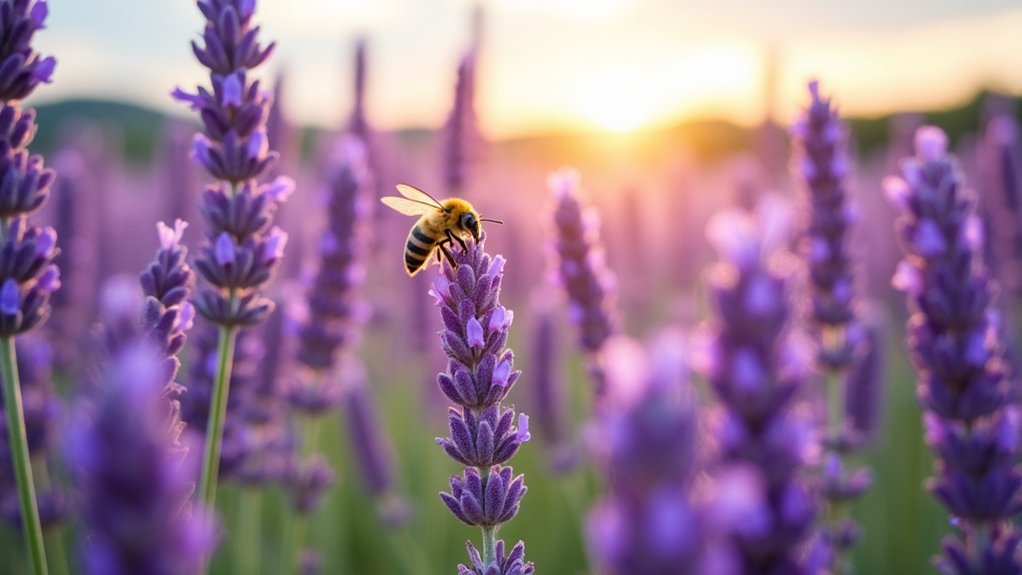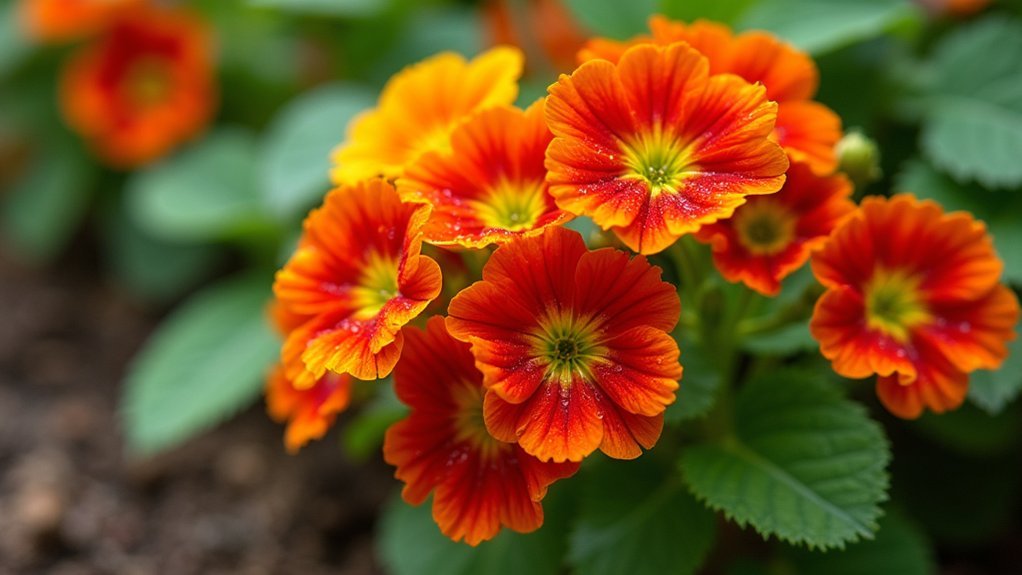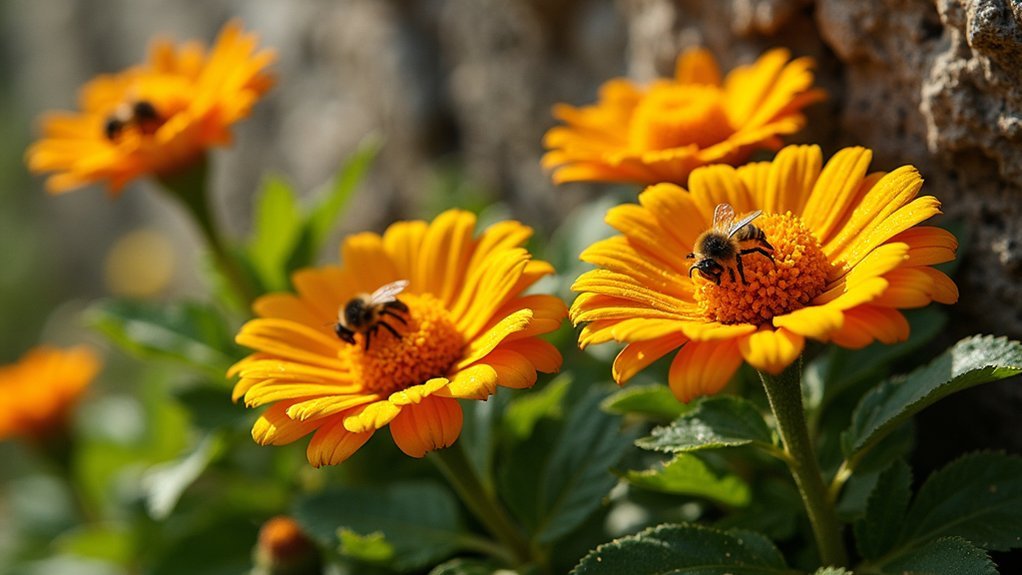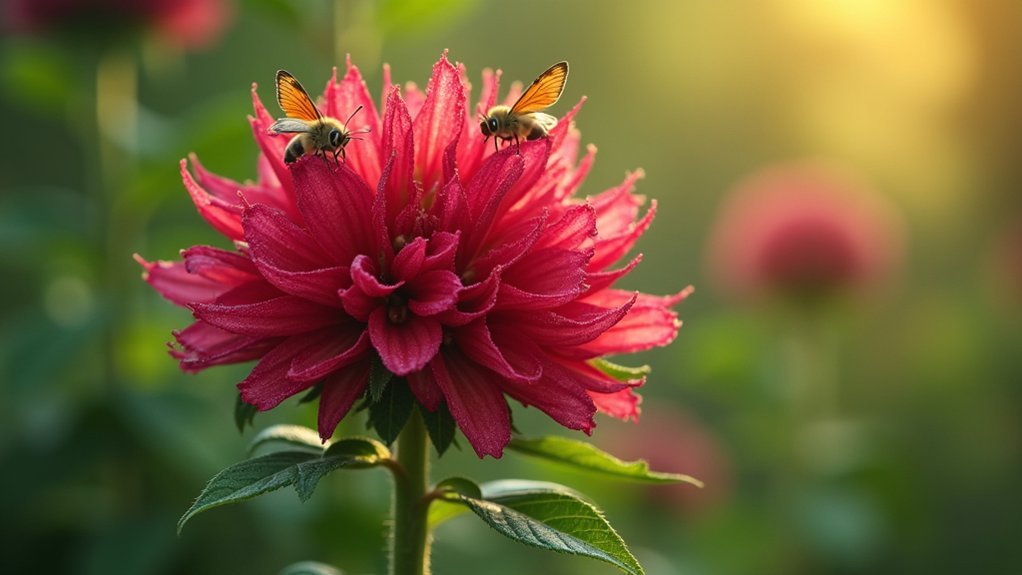Seven flowering plants that delight both pollinators and humans include lavender with its calming fragrance, sunflowers as biodiversity beacons, nasturtiums offering peppery edible blooms, borage with cucumber-flavored star flowers, calendula for its edible golden petals, wild roses supporting urban ecosystems, and bee balm attracting hummingbirds with vibrant blooms. You'll boost your garden's ecological value while enjoying culinary and medicinal benefits from these versatile botanical wonders.
Lavender: Purple Paradise for Bees and Boulevards

Enchantment blooms in both garden and wilderness where lavender grows. This resilient flowering plant offers a purple paradise that serves both pollinator populations and your landscape design ambitions.
Nature's purple tapestry unfolds where lavender thrives, creating sanctuary for pollinators while enhancing your garden's visual poetry.
You'll notice bees flock enthusiastically to lavender's fragrant flowers, drawn by its abundant nectar and the purple hue that appears differently to their ultraviolet-sensitive vision than to your eyes. When many food sources dwindle in late spring and early summer, lavender steps in as a vital feeding station for these essential pollinators.
What makes lavender particularly valuable is its adaptability. You can plant it in poor soil where other plants struggle, and it'll thrive even during drought conditions.
This sustainability factor, combined with its beauty and fragrance, makes lavender a perfect choice for eco-conscious gardeners.
Sunflowers: Towering Beacons of Urban Biodiversity
You'll find sunflowers serve as towering nectar factories, reaching heights up to 12 feet while producing abundant resources that attract diverse pollinators.
Their massive flower heads act as natural beacons in urban settings, creating vibrant islands of biodiversity amid concrete landscapes.
Towering Nectar Producers
Standing tall against urban skylines, sunflowers transform ordinary spaces into pollinator paradises with their impressive stature and abundant nectar production.
Reaching towering heights of up to 10 feet, these golden giants serve as essential nectar producers in your garden, attracting bees, butterflies, and even hummingbirds.
Each sunflower head contains thousands of tiny florets, with each one capable of yielding 1.5 microliters of nectar—creating an incredible buffet for pollinators throughout summer.
When you plant sunflowers, you're strengthening the mutualistic relationship between flowering plants and their pollinators while enhancing urban biodiversity.
Urban Pollinator Magnets
Thriving in concrete jungles where biodiversity often struggles, sunflowers act as powerful pollinator magnets that transform urban landscapes into vibrant ecological hotspots.
You'll notice these towering beacons, reaching up to 10 feet tall, attracting bees, butterflies, and birds with their radiant yellow blooms.
When you plant sunflowers in your urban garden, you're creating a rich source of nectar and pollen that supports local insect populations.
Their bright petals enhance visibility, signaling abundant food resources to passing pollinators.
You're not just beautifying your space—you're actively contributing to ecosystem health by improving pollinator foraging success.
As a bonus, you'll enjoy edible seeds packed with nutrients that can be harvested for your own consumption or oil production—making sunflowers beneficial for both pollinators and people in urban environments.
Nasturtiums: Peppery Delights for Pollinators and Plates

Among the most versatile additions to any garden, nasturtiums (Tropaeolum majus) offer a remarkable combination of beauty and utility that few flowering plants can match. Their vibrant blooms attract bees and butterflies with abundant nectar, while you'll appreciate these edible flowers as a culinary delight, adding peppery zest to your salads.
You'll find nasturtiums thrive in poor soil conditions, making them perfect for challenging garden spots. They'll work double-duty as companion plants by deterring aphids and whiteflies from your vegetables.
For an extra treat, harvest their seeds and pickle them as a homemade caper substitute. With blooms lasting from early summer until frost, these plants provide sustained nourishment for pollinators while continuously supplying your kitchen with colorful, flavorful garnishes.
Borage: The Star-Flowered Wonder of City Gardens
You'll be enchanted by borage's vibrant blue star-shaped flowers that serve as powerful magnets for bees and other essential pollinators.
These striking blooms aren't just pretty—they're packed with medicinal properties that can help reduce stress and anxiety while providing valuable gamma-linolenic acid.
Beyond its therapeutic benefits, borage earns its place in your city garden by improving soil health and offering cucumber-flavored leaves and flowers for your culinary creations.
Bee-Friendly Blue Blooms
You'll fall in love with borage's vibrant blue star-shaped flowers that transform your city garden into a pollinator paradise.
This bee-friendly plant produces abundant nectar that honey bees can't resist, even in poor urban soil conditions.
As an excellent companion plant, borage enhances pollination rates in neighboring plants, increasing your garden's overall productivity.
Try these three simple ways to incorporate borage:
- Plant borage near struggling vegetables to attract pollinators and boost their yield
- Add the edible flowers to summer drinks and salads for a cucumber-like flavor
- Create a dedicated pollinator patch where these blue blooms can self-seed year after year
Your garden deserves this hardy annual that serves both bees and your kitchen equally well.
Medicinal Garden Powerhouse
Three remarkable healing properties make borage a standout choice for any medicinal garden. This potent medicinal herb contains gamma-linolenic acid that supports skin health, traditionally addresses inflammation, and helps with respiratory conditions—all while enhancing your garden's biodiversity.
You'll love how borage's striking star-shaped blue blooms provide essential pollination services while flourishing in urban environments. Even in less-than-ideal conditions, this hardy plant thrives in well-drained soil and full sun, making it perfect for city gardens.
The versatility of borage extends beyond medicine—its edible flowers add vibrant color to your culinary creations while simultaneously offering nectar or pollen to bees and other pollinators.
Calendula: Edible Golden Blooms That Thrive in Forgotten Spaces

When gardens need a splash of golden resilience, calendula stands ready to transform even the most neglected corners into vibrant habitats for pollinators.
Nature's golden ambassador, calendula brings life to forgotten spaces while serving both pollinators and gardeners alike.
This versatile plant thrives in poor soil conditions where other flowers falter, creating biodiversity hotspots in otherwise barren spaces.
You'll appreciate calendula for three compelling reasons:
- Extended blooming season – These resilient flowers provide continuous nectar from early spring through late fall
- Edible versatility – Add the vibrant petals to salads, teas, and natural food colorings
- Medicinal benefits – Harness their traditional anti-inflammatory and wound-healing properties
Wild Roses: Ancient Allies for Urban Ecosystem Health
Survivors from prehistoric times, wild roses have quietly sustained urban ecosystems while concrete and asphalt reshape our landscapes.
These resilient plants serve as essential food sources for pollinators like bees and butterflies, creating biodiversity hotspots in otherwise barren urban environments.
When you plant wild roses, you're establishing a significant habitat that counteracts urban habitat loss. Their fragrant blooms attract diverse pollinators, promoting cross-pollination and genetic diversity among surrounding plant populations. This strengthens the entire ecosystem's resilience.
Beyond their beautiful flowers, wild roses produce vitamin C-rich hips that nourish birds and wildlife throughout winter.
Bee Balm: Crimson Crown Jewels of Community Gardens

Fiery red blooms atop sturdy stems distinguish bee balm as the crimson crown jewel in community gardens nationwide. This native perennial plant doesn't just catch your eye—it's a biodiversity powerhouse, attracting bees, butterflies, and hummingbirds with its vibrant flowers and abundant nectar.
You'll love bee balm for three key reasons:
- It's remarkably adaptable, thriving in various soil conditions while reaching impressive heights of 2-4 feet.
- Its aromatic leaves serve culinary purposes, creating delicious teas and herbal infusions.
- It carries medicinal properties historically valued by Indigenous peoples.
When you plant bee balm, you're not just adding beauty to your community garden—you're creating an ecological hub that supports pollinators while offering practical benefits for human gardeners too.
Frequently Asked Questions
What Is Relationship Between Flowering Plants and Humans?
You depend on flowering plants for food, as they provide one-third of your diet. They also offer beauty, support biodiversity, and sustain ecosystems that you need for survival and well-being.
Do Plants and Pollinators Have a Symbiotic Relationship?
Yes, plants and pollinators have a classic symbiotic relationship. You'll notice they've coevolved beautifully—plants provide food rewards like nectar, while pollinators transfer pollen between flowers, ensuring plant reproduction. It's mutually beneficial cooperation.
What Is an Example of a Plant and Pollinator Relationship?
You'll find a perfect example in European honey bees and Rosaceae family plants like apple trees. The bees collect nectar and pollen for food while simultaneously pollinating the flowers, benefiting both species.
What Plant Attracts the Most Pollinators?
You'll find native wildflower mixtures attract the most diverse range of pollinators. Sunflowers, lavender, coneflowers, and milkweed are particularly effective, with sunflowers drawing the widest variety of pollinating species to your garden.
In Summary
You've now discovered seven amazing flowering plants that bridge the gap between human needs and pollinator habitat. Whether you're cultivating a sprawling garden or nurturing a modest balcony pot, these versatile blooms will transform your space into a thriving ecosystem. By planting these dual-purpose flowers, you're not just creating beauty—you're actively supporting essential pollinators while enhancing your own environment with edible, medicinal, and visually stunning additions.





Leave a Reply